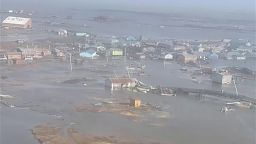UPDATE: Severe flooding in remote villages of Alaska has left over 2,000 residents displaced, with Governor Mike Dunleavy announcing that many may not return home for at least 18 months. This urgent situation follows the catastrophic impact of Typhoon Halong, which struck with the force of a Category 2 hurricane, devastating communities in the region.
In Kipnuk, initial assessments reveal that 121 homes—nearly 90% of the village—have been destroyed. Meanwhile, in Kwigillingok, approximately one-third of houses are uninhabitable after being swept away by floodwaters. One individual has been confirmed dead, with two others still missing as rescue efforts continue.
Authorities report that rescue crews have successfully airlifted dozens of individuals from homes that were inundated. Many evacuees are currently sheltered in schools and larger community centers, with military planes evacuating residents to Anchorage, Alaska’s largest city. As of now, the Alaska National Guard has transported around 575 people to Anchorage, where officials anticipate welcoming up to 1,600 evacuees over the coming days.
Governor Dunleavy has requested a major disaster declaration from the White House. This would enable federal assistance for individuals and public infrastructure recovery. The three members of Alaska’s congressional delegation have also urged swift approval for the declaration, emphasizing the dire need for support in the wake of widespread devastation.
“The time, space, distance, geography, and weather in the affected areas make it unlikely that many survivors can return to their communities this winter,” Dunleavy stated. He emphasized that emergency repairs are being prioritized, although some areas may not be suitable for winter occupancy in “America’s harshest climate.”
Evacuees like Alexie Stone from Kipnuk are facing a challenging transition. He arrived in Anchorage with his family and is now seeking employment as they adapt to a new life in the city. “It’s going to be, try to look for a place and find a job,” he shared, highlighting the emotional toll of starting anew.
Anchorage officials are mobilizing resources to assist evacuees. Mayor Suzanne LaFrance remarked, “Our neighbors in western Alaska have experienced tremendous loss, devastation, and grief. We will do everything we can here in Anchorage to welcome our neighbors and help them through these difficult times.”
Community leader and State Representative Nellie Unangiq Jimmie described her harrowing experience during the storm, recounting how she and her family were forced to wait and see if their home would withstand the storm’s 100 mph winds. “You are showing my people, my relatives, my constituents… this is still Alaska land and they’re amongst families,” she expressed, thanking Anchorage for its support.
As rescue and recovery efforts continue, officials are exploring options for transitioning evacuees from emergency shelters to short- and long-term housing solutions. The federal government’s ongoing assistance with search and rescue operations, damage assessments, and environmental responses remains critical in the coming weeks.
This situation is developing rapidly, and residents are urged to stay updated on further announcements and assistance initiatives as the community begins to heal from this unprecedented disaster.
